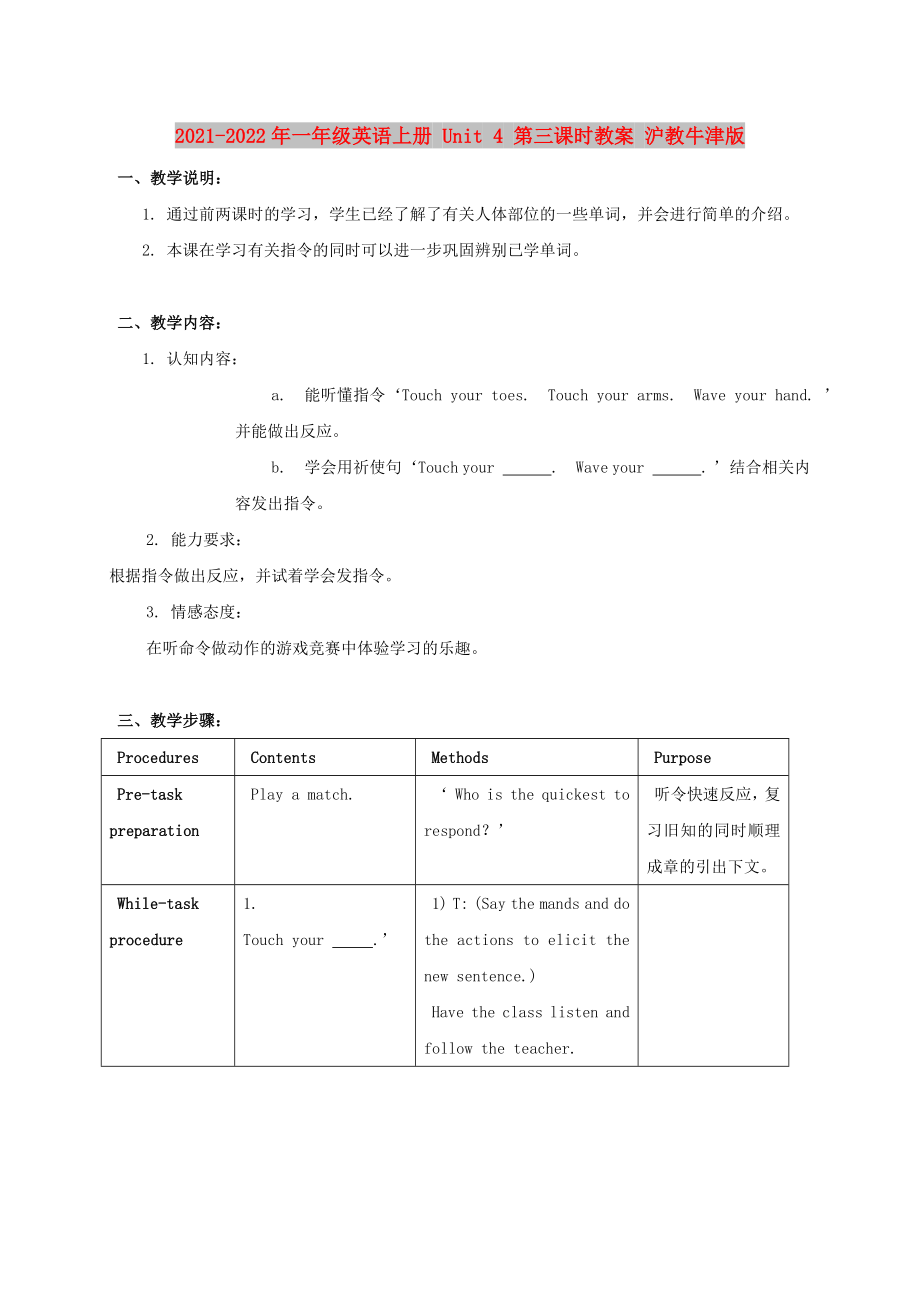《2021-2022年一年級(jí)英語(yǔ)上冊(cè) Unit 4 第三課時(shí)教案 滬教牛津版》由會(huì)員分享���,可在線(xiàn)閱讀���,更多相關(guān)《2021-2022年一年級(jí)英語(yǔ)上冊(cè) Unit 4 第三課時(shí)教案 滬教牛津版(6頁(yè)珍藏版)》請(qǐng)?jiān)谘b配圖網(wǎng)上搜索。
1���、2021-2022年一年級(jí)英語(yǔ)上冊(cè) Unit 4 第三課時(shí)教案 滬教牛津版
一����、教學(xué)說(shuō)明:
1. 通過(guò)前兩課時(shí)的學(xué)習(xí)�,學(xué)生已經(jīng)了解了有關(guān)人體部位的一些單詞,并會(huì)進(jìn)行簡(jiǎn)單的介紹���。
2. 本課在學(xué)習(xí)有關(guān)指令的同時(shí)可以進(jìn)一步鞏固辨別已學(xué)單詞��。
二���、教學(xué)內(nèi)容:
1. 認(rèn)知內(nèi)容:
a. 能聽(tīng)懂指令‘Touch your toes. Touch your arms. Wave your hand. ’并能做出反應(yīng)�����。
b. 學(xué)會(huì)用祈使句‘Touch your . Wave your . ’結(jié)合相關(guān)內(nèi)容發(fā)出指令�。
2. 能力要求:
根據(jù)指令做出反應(yīng)����,并試著
2����、學(xué)會(huì)發(fā)指令。
3. 情感態(tài)度:
在聽(tīng)命令做動(dòng)作的游戲競(jìng)賽中體驗(yàn)學(xué)習(xí)的樂(lè)趣���。
三�����、教學(xué)步驟:
Procedures
Contents
Methods
Purpose
Pre-task preparation
Play a match.
‘ Who is the quickest to respond���?’
聽(tīng)令快速反應(yīng),復(fù)習(xí)舊知的同時(shí)順理成章的引出下文���。
While-task procedure
1.
Touch your .’
1) T: (Say the mands and do the actions to elicit the new sente
3���、nce.)
Have the class listen and follow the teacher.
2) Teach a rhyme about body parts:
‘ Touch your eyes,
And touch you toes.
Touch your ears,
And touch your nose.’
邊做動(dòng)作���,邊說(shuō)兒歌,理解含義����,熟練句式。
2.
Wave your .’
1)
pare the mands:
‘ Raise your hand.
Wave your hand.’
利用動(dòng)作的演示區(qū)分兩者的含義�。
2)
4、 Ask students to listen to the teacher’s mands and do the actions.
3) Quick response.
聽(tīng)令快速反應(yīng)�,在實(shí)踐中進(jìn)一步區(qū)別raise 和wave 的不同含義。
3. ‘ Who is the best little teacher��?’
Ask some more able students to order the mands. The others try to follow and act.
為學(xué)生創(chuàng)造鍛煉的機(jī)會(huì)�����,充分發(fā)揮小老師的功能��。
Post-task activity
Play
5��、a game.
‘Simon Says’
滾動(dòng)知識(shí)��,豐富語(yǔ)言庫(kù)。
Assignment
Play the game (Simon Says) with their friends or parents.
四���、教學(xué)步驟:
1. 教學(xué)關(guān)注點(diǎn):
理解?Wave your hand. 和Raise your hand. 兩者之間在意義上的區(qū)別并作出相應(yīng)的動(dòng)作��。
2. 設(shè)計(jì)思路:
Let’s act 的內(nèi)容和動(dòng)作緊密相連��,使愛(ài)動(dòng)的他們?cè)趯W(xué)習(xí)過(guò)程中通過(guò)肢體語(yǔ)言的支持學(xué)得更快��、記得更牢���。
3. 教學(xué)反思:
a. 通過(guò)說(shuō)說(shuō)做做��,學(xué)生對(duì)句子的意思理解了���,記得也牢了��,學(xué)得也更快樂(lè)了�����。
6���、
b. 輪到小老師發(fā)令時(shí)����,發(fā)現(xiàn)他們所說(shuō)的句式局限于本單元的學(xué)習(xí)內(nèi)容�,應(yīng)引導(dǎo)學(xué)生把前幾個(gè)單元的指令一起加入其中,力求使學(xué)生所學(xué)的知識(shí)能隨時(shí)間的推移而滾雪球似地增加���。
附送:
2021-2022年一年級(jí)英語(yǔ)上冊(cè) Unit 4 第二課時(shí)教案 滬教牛津版
一��、教學(xué)說(shuō)明:
1. 通過(guò)前教時(shí)的學(xué)習(xí)��,學(xué)生已經(jīng)能聽(tīng)聽(tīng)���、說(shuō)說(shuō)、唱唱���、指指臉部的各部位�。
2. 本課繼續(xù)學(xué)習(xí)有關(guān)人體部位的內(nèi)容��,并嘗試著用This is my ……介紹自己身體各部位以及身邊的事物���。
二�����、教學(xué)內(nèi)容:
1. 認(rèn)知內(nèi)容:
a. 能根據(jù)指令做出反應(yīng)����,例如:Draw a nose.
b. 學(xué)會(huì)用單詞hand、arm����、l
7、eg�����、toe等表述人體部位�。
c. 能用句型‘This is my ……’進(jìn)行介紹。
2. 能力要求:
學(xué)會(huì)用This is my ……介紹自己身體各部位以及身邊的事物�。
3. 情感態(tài)度:
通過(guò)介紹,激發(fā)學(xué)生大膽表現(xiàn)自我的情感�����,并樹(shù)立信心�����。
三�����、教學(xué)步驟:
Procedures
Contents
Methods
Purpose
Pre-task preparation
1. Song
Encourage students to sing the song together.
優(yōu)美的旋律��、動(dòng)聽(tīng)的歌曲����,為學(xué)生創(chuàng)設(shè)一個(gè)輕松愉快的英語(yǔ)學(xué)習(xí)氛圍。
2. Quick resp
8���、onse.
1) Listen��,say and point.
聽(tīng)音指向��、聽(tīng)音判斷����,在復(fù)習(xí)的同時(shí)為進(jìn)一步學(xué)習(xí)做準(zhǔn)備�����。
2) Listen and judge.
While-task procedure
1. Play a match.
‘ Who is the better painter�����?’
Draw a face on the board with all the features missing. Ask two students to close their eyes and draw the missing parts according to the mands.
9、E.g.: Draw two eyes.
蒙眼畫(huà)像��,在競(jìng)賽中鞏固舊知�,導(dǎo)入新課。
2. Draw a face.
In groups���,students draw their faces on page 20 and practise saying ‘ This is my eye’����,‘This is my ear’���,etc.
體驗(yàn)為自己畫(huà)像的感覺(jué)并嘗試著介紹���。
3. Introduction
‘hand,arm�����,leg����, foot,toe……’
1) Teacher shows a doll to introduce its body parts����,imitating a doll
10、’ s voice.
利用對(duì)娃娃的介紹引出其他人體部位���。
2) Introduce the body parts.
E.g.: This is my hand ……
4. Imitation
‘This is my hand ……’
1) Prompt the students to follow the teacher. Point and say the sentences as following:
E.g.: Hand��,hand����,this is my hand. Arm�����,arm���,this is my arm ……
有節(jié)奏地練說(shuō)句型���。
2) In pairs,s
11�、tudents take turns to introduce their body parts and do the actions.
互相介紹,增進(jìn)了解�。
3) Select pairs to act out the role play to the class.
Post-task activity
Group work.
Encourage students to introduce their personal items to the class.
E.g.: ‘ Look! This is my ruler. This is my book. ’,etc.
從生
12、活中�,從自己身邊尋找素材,提高實(shí)際運(yùn)用英語(yǔ)的能力��。
Assignment
Ask students to introduce themselves.
四����、教學(xué)步驟:
1. 媒體準(zhǔn)備:錄音機(jī),歌曲磁帶��,圖片���,娃娃���,學(xué)習(xí)用品等。
2. 教學(xué)關(guān)注點(diǎn):
引導(dǎo)學(xué)生自信的表現(xiàn)自我�。
3. 設(shè)計(jì)思路:
a. 抓住兒童年齡特點(diǎn),設(shè)計(jì)和開(kāi)展豐富多彩的游戲活動(dòng)����,如:聽(tīng)音指向、聽(tīng)音判斷����、蒙眼比賽畫(huà)像等�����,使教學(xué)內(nèi)容輕松易學(xué)。
b. 在學(xué)了Let’s talk的內(nèi)容后���,請(qǐng)學(xué)生介紹周?chē)膶W(xué)習(xí)用品���,和Unit 1中的內(nèi)容來(lái)個(gè)呼應(yīng),提高語(yǔ)言的復(fù)現(xiàn)率���,注重語(yǔ)言知識(shí)的積累���,同時(shí)努力提高實(shí)際運(yùn)用英語(yǔ)的能力。
4. 教學(xué)反思:
針對(duì)學(xué)生的特點(diǎn)���,選擇行之有效的游戲穿插其中��,可以分散難點(diǎn)�、降低難度�����,讓學(xué)生玩中學(xué)、學(xué)中玩�����,在愉快的游戲中不知不覺(jué)學(xué)到知識(shí)����。
 2021-2022年一年級(jí)英語(yǔ)上冊(cè) Unit 4 第三課時(shí)教案 滬教牛津版
2021-2022年一年級(jí)英語(yǔ)上冊(cè) Unit 4 第三課時(shí)教案 滬教牛津版

